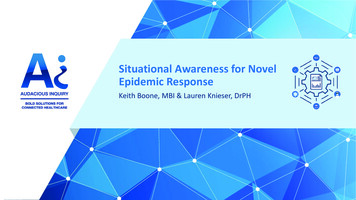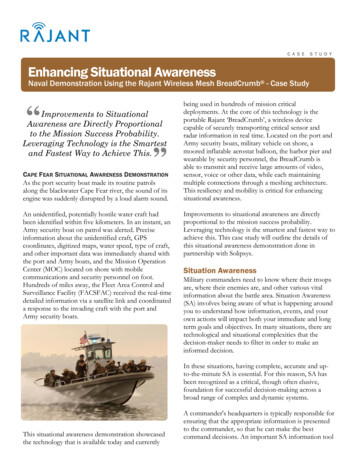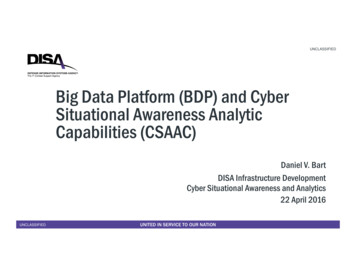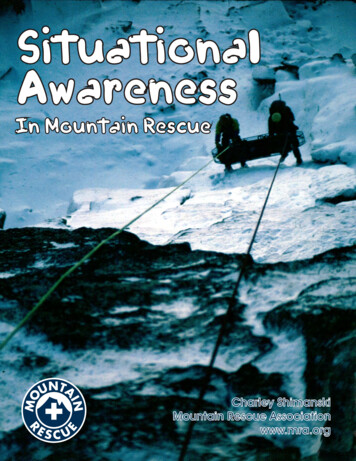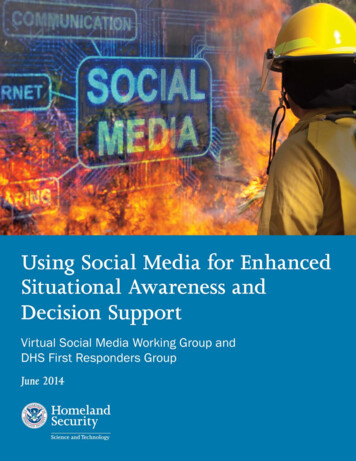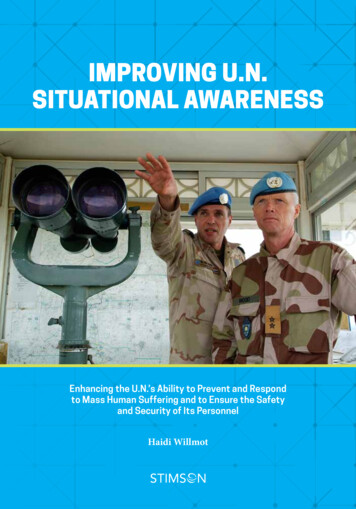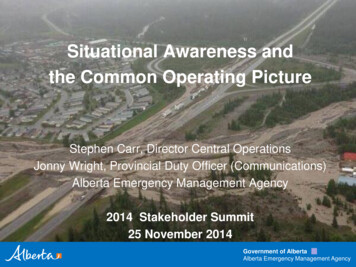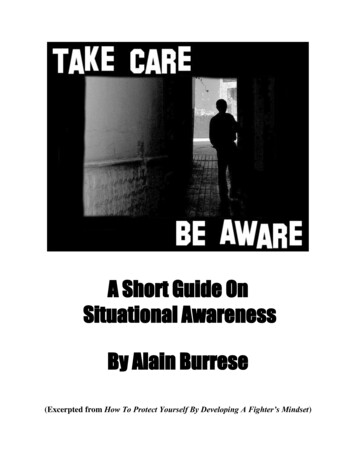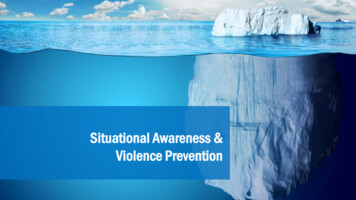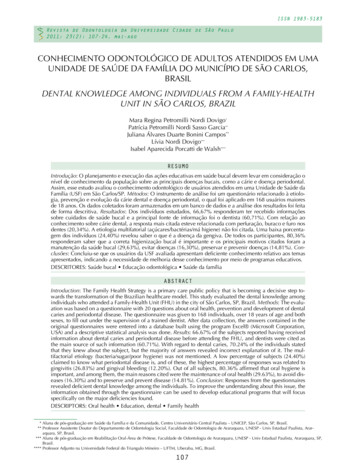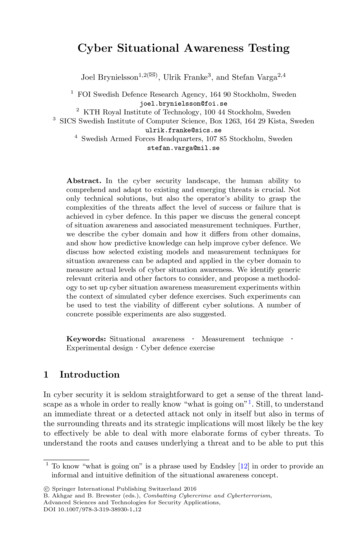
Transcription
Cyber Situational Awareness TestingJoel Brynielsson1,2(B) , Ulrik Franke3 , and Stefan Varga2,413FOI Swedish Defence Research Agency, 164 90 Stockholm, Swedenjoel.brynielsson@foi.se2KTH Royal Institute of Technology, 100 44 Stockholm, SwedenSICS Swedish Institute of Computer Science, Box 1263, 164 29 Kista, Swedenulrik.franke@sics.se4Swedish Armed Forces Headquarters, 107 85 Stockholm, Swedenstefan.varga@mil.seAbstract. In the cyber security landscape, the human ability tocomprehend and adapt to existing and emerging threats is crucial. Notonly technical solutions, but also the operator’s ability to grasp thecomplexities of the threats affect the level of success or failure that isachieved in cyber defence. In this paper we discuss the general conceptof situation awareness and associated measurement techniques. Further,we describe the cyber domain and how it differs from other domains,and show how predictive knowledge can help improve cyber defence. Wediscuss how selected existing models and measurement techniques forsituation awareness can be adapted and applied in the cyber domain tomeasure actual levels of cyber situation awareness. We identify genericrelevant criteria and other factors to consider, and propose a methodology to set up cyber situation awareness measurement experiments withinthe context of simulated cyber defence exercises. Such experiments canbe used to test the viability of different cyber solutions. A number ofconcrete possible experiments are also suggested.Keywords: Situational awareness · Measurement techniqueExperimental design · Cyber defence exercise1·IntroductionIn cyber security it is seldom straightforward to get a sense of the threat landscape as a whole in order to really know “what is going on”1 . Still, to understandan immediate threat or a detected attack not only in itself but also in terms ofthe surrounding threats and its strategic implications will most likely be the keyto effectively be able to deal with more elaborate forms of cyber threats. Tounderstand the roots and causes underlying a threat and to be able to put this1To know “what is going on” is a phrase used by Endsley [12] in order to provide aninformal and intuitive definition of the situational awareness concept.c Springer International Publishing Switzerland 2016 B. Akhgar and B. Brewster (eds.), Combatting Cybercrime and Cyberterrorism,Advanced Sciences and Technologies for Security Applications,DOI 10.1007/978-3-319-38930-1 12
210J. Brynielsson et al.information in an overall cyber arena context, is what cyber situational awareness2 (CSA) is about. Such CSA will help the decision-maker/analyst to betterunderstand the organisational implications, and how to assess and act given thata threat or an attack has been detected. As identified in previous work [20], CSAis considered to be the part of situational awareness which concerns the “cyber”environment, whilst at the same time acknowledging that acquiring and upholding CSA requires that external factors concerning, e.g., the physical environment,the political dimension, etc., need to be taken into account.The cyber threat is omnipresent in today’s connected world, and the necessityto uphold a high level of CSA naturally follows in many operational applications.Examples include the importance for IT departments to be able to distinguishbetween “background noise,” e.g., attack attempts with slim chances of success,and more advanced attempts with potentially severe effects, and for intelligencepersonnel to understanding a cyber attack strategically in terms of its politicalimplications. Related to the sought for operational CSA capacity, it follows thatthe ability to acquire and maintain a high level of CSA is also something thatought to govern educational endeavours. Moreover, the usefulness of solutions fortackling the cyber threat—be it technology, processes, or policies—is also closelyrelated to CSA since the level of CSA that a solution provides, is a measure ofits usefulness. As a consequence, it is important to develop reliable and validmeasures of, and ways to measure, CSA so that, e.g., relevant training goals canbe stated and cyber solutions can be evaluated.The present paper presents an overview of existing situation awareness measurement techniques, and exemplifies how these techniques can be used for CSAmeasurement. The paper is structured as follows. Section 2 introduces the readerto the area of CSA and provides the necessary background regarding situationalawareness. Then, Sect. 3 reviews the area of situational awareness measurement,and discusses measurement design from a cyber perspective. Next, Sect. 4 discusses experiment design considerations in general and how to perform measurement through using cyber defence exercises (CDXs) in particular, which isfollowed by a practical example of how to setting up a CDX for being able totrain for a diversion attack. Finally, Sect. 5 concludes the paper.2BackgroundThe purpose of this section is to frame the concept of situation awareness andits development. Situation awareness existed before [8] the publication of MicaR. Endsley’s seminal article entitled “Toward a Theory of Situation Awarenessin Dynamic Systems” [12], but a wider acceptance of the theories undoubtedlyseem to have gained traction in the academic community thereafter as manifested by increasing numbers of research papers on the subject [40]. The reasonfor studying situation awareness, SA, in the first place is the assumption thatgood SA contributes to better system design, which in turn ultimately leads to2In this paper we use the terms “situation awareness” and “situational awareness”interchangeably.
Cyber Situational Awareness Testing211better decisions, actions and more successful mission outcomes. There are severalproposed models for SA, but many of those appear to view the SA construct differently, and most models focus on the process of acquiring SA from the view ofan individual operator as opposed to the multiple individual perspective whereacquiring of shared or team SA is emphasised [45]. There are, however, theoriesthat specifically aim to describe and measure phenomena such as team awareness, shared situation awareness and distributed shared awareness, DSA, andthe like [1,44]. According to Artman [1], team members in a studied militarycommand and control setting created SA at least by their interactions with theenvironment through active monitoring, negotiation with other team members,and by use of artefacts. Thus, when situation awareness theories involve groupsor teams, a social dimension is also added.According to Stanton et al. [52], three models and their associated theoretical perspectives dominate. Besides Endsley’s three-level model, here: Endsley’smodel, there is the perceptual cycle model [50] and the activity theory modelof Bedny and Meister [2]. In short, the perceptual cycle model emphasises thatsituation awareness is dependent on the task environment and that situationawareness is externally-directed, that goals and criteria for performance mustbe explicit in the environment and that the cyclic nature, as suggested by thename of the model, is due to the assumption that knowledge influences behaviour, which in turn sometimes affects and modifies the environment [50]. Theactivity model, which is a significantly larger construct than Endsley’s model,gives that situation awareness can not be viewed in isolation, and that otherbehavioural concepts tied to human activity have to be understood as well [2].To summarise, all three models of situation awareness build upon the assumptionthat the operator has to have a cyclic iterative interaction with the environment,but the perceptual cycle model emphasises the need for interaction with regardto perception, and the activity theory model emphasises the interplay via performed actions. We will not elaborate further on the perceptual cycle model orthe activity theory model in this paper.Endsley’s model of situation awareness has found its use and gained widespread acceptance during the years as reflected in the contemporary literature,even if the scientific rigour of some of its theoretical underpinnings or differentdefinition issues are questioned by some [4,5,19,48]. The formal definition of SA,due to Endsley [8], is that it denotes a person’s “perception of the elements inthe environment within a volume of time and space, the comprehension of theirmeaning and the projection of their status in the near future.” In addition, theperson, or operator, also has to have an understanding of the relevant parametersof the system itself [11].Endsley’s model emerged from the aviation domain. She submits that theabove mentioned definition merely specifies the scope of the situation awareness construct, and that the elements for different aircrafts or, indeed, systems,have to be determined [10] for each domain. She also proposed a methodology, situation awareness requirements analysis, for the task of determining thoseelements for the air-to-air combat fighters domain [10]. Other areas for which
212J. Brynielsson et al.relevant elements have been identified include, for example, en route air trafficcontrol [15] and command of infantry platoons [35]. The proposed methodologyincludes the consecutive steps of conducting unstructured interviews with subject matter experts, SMEs, followed by a goal-directed task analysis in whichgoals, sub-goals and SA requirements to meet those goals are determined. In thenext phase a structured questionnaire is submitted to another group of SMEs inorder to add an objective assessment to the goals identified in previous phases.Each item is then rated depending on its criticality to reach the sub-goals. Theresulting battery of questions about the identified parameters, is intended for themeasurement of all three levels of situation awareness. To have a set of questionsthat reflects the relevant aspects of situation awareness is a critical prerequisiteneeded to perform further measurements of an operator’s, or a team of operators’, SA.2.1Evaluation of Cyber Threat InsightAs indicated above, situational awareness is often defined following Endsley [8] as“the perception of the elements in the environment within a volume of time andspace, the comprehension of their meaning and the projection of their status inthe near future.” As suggested by Endsley in later work [12], this definition canbe seen as delineating ascending levels of awareness ranging from (1) mere basicperception of important data, over (2) interpretation and combination of datainto knowledge, to (3) the ability to predict future events and their implications.In this paper we define cyber situational awareness to be the part of situational awareness which concerns the “cyber” environment. In other words, CSAis what enables system administrators and incident managers to swiftly andappropriately respond to cyber attacks and other incidents pertaining to theiroperations. However, to acquire and uphold appropriate CSA requires a fullunderstanding of the threat in order to be able to plan strategically for appropriate actions concerning, e.g., training undertakings, possible insider threats,etc. Hence, CSA needs to be understood not only in itself but also with respect toexternal factors concerning, e.g., the physical environment, the political dimension, etc.It is easy to see that lack of appropriate CSA makes victims more vulnerableto cybercrime (CC). This is all the more true today, when many crimes alsohave an IT aspect in them. For example, in June 2011, enterprise networks inthe port of Antwerp, Belgium, were hacked by drug traffickers, so as to facilitatetheir smuggling operations alongside legitimate goods delivered in containers.By manipulating the dispatching of containers upon arrival, the smugglers wereable to retrieve the containers holding drugs before the legitimate containerowners did. The operation was exposed only when port workers started to noticecontainers disappearing for no apparent reason. Once the criminal operation wasexposed, the police seized over two tons of cocaine and heroin, and more than amillion euros [17].Another example which is interesting to reflect upon from the perspective ofCSA is the digital bank attack tactics exposed by Symantec in 2012: distributed
Cyber Situational Awareness Testing213denial of service (DDoS) attacks are no longer just a blunt tool that causes a lotof annoyance, but less harm. Rather, attackers have started to use DDoS attacksas diversions, in order to draw the attention of system administrators away froma more sophisticated attack3 . This kind of tactic really emphasises the need notonly to perceive lots of data (e.g., by means of intrusion detection systems, etc.)but also to correctly interpret it in order to predict what the adversary will donext. In other words, countering these new and sophisticated attacks hinges onproper CSA.3Measurement of Awareness LevelThe formal definition of situational awareness according to Sect. 2.1 has gainedacceptance during the years and is widely used throughout the contemporaryliterature. Testing of situational awareness, however, has not matured into anequally well-defined tool set. Endsley’s definition suggests that situation awareness can be reached in a gradual manner where the understanding on higherlevels to some extent depends on the awareness on lower levels, but not in alinear way [14]. To test to what extent there is an understanding of the situationin terms of these levels typically requires that specific measurement solutions aredeveloped in order to account for the specific domain. It follows that the validityof situational awareness measurement, and of CSA measurement as a means toevaluate cyber solutions, is closely related to (1) the measurement design, takentogether with (2) the application of interest.Concerning measurement design, many more or less elaborate and valid methods to measure SA exist. Hence, to determine whether it is possible to evaluate/test a cyber solution in terms of achieved CSA then amounts to identifyingwhether the cyber solution, in itself or a part of it, lends itself to CSA measurement, and, if so, to identifying a suitable activity where CSA can be measuredusing existing SA measurement techniques. Depending on the need, this activitycan, e.g., be a small-scale exercise or a full-scale CDX using an exercise designwhere it is possible to perform relevant training whilst at the same time evaluating to what extent the cyber solution has resulted in individual understandingof the overall cyber situation. To measure the obtained CSA the exercise is typically frozen at randomly selected times and subjects are queried as to theirperception of the situation at the time (queries on specific data or data criteria).The reasoning behind the randomly selected times of breaks is that it will notbe possible for the subject to mentally prepare for the queries. Hence, it needsto be stressed that SA (and thereby CSA) is a distinct and unique phenomenon which applies to individuals’ mental models in a universal sense. It refersto the availability of a comprehensive and coherent situation representation ofwhat is currently known, and which is continuously being updated based on theindividual’s recurring assessment of the acks/.
214J. Brynielsson et al.As indicated, the three levels to be measured and distinguished betweenduring CSA measurement consist of perception, comprehension, and projection.From a cyber security perspective, the perception level thus concentrates on theperception of cyber environment changes including, e.g., noticing an intrusiondetection system alarm, whilst the comprehension level focuses on the understanding of what this actually means in terms of, e.g., a website defacementattack, a new kind of friendly user behaviour, etc. Finally, the projection levelsignifies a more in-depth understanding of the situation in that one is also ableto make predictions concerning the forthcoming development of the situationto make informed decisions regarding how to act in order to manage the situation. For the purpose of constituting a means for assessment of cyber solutions,it is necessary that the cyber solution—be it a technical tool, a methodology,or something else—lends itself to testing with regard to understanding of someaspect of the cyber environment along the lines of perception, comprehension,and projection.The objective for all kinds of measurement is to be able to compare anobject or event with another. Stanley Smith Stevens, who made contributions tothe field of measurement theory, states that it for measurement is essential that“numbers are assigned to aspects of objects or events according to one or anotherrule or convention” [53]. Accordingly it follows, when we have those numbers,that they have to be compared to something. For SA, the operator’s SA has tobe compared to, ideally, an objective truth in order to be able to rate the level ofSA. Parasuraman et al. [39] claim, without further comment, that there is sucha “ground truth” against which the SA can be compared, while Dekker et al. [5]vehemently argue against the feasibility of acquiring such a “ground truth” asunattainable since it requires an aperspectival, e.g., extracorporeal, objectivity.As we have established that the forms of situation awareness are highly contextdependent, the question of what constitutes the situation, and what the relevantaspects are, therefore arises.To address that problem, however, there are a number of techniques that aredeveloped with specific SA target domains in mind. The techniques are assertedto inherently provide a sufficiently good “ground truth” and they also to someextent prescribe how and what to measure. Further, Salmon et al. [47] make thepoint that most measurement techniques are, consequently, developed in linewith corresponding specific models.According to an excellent inventory of situation awareness measurementmethodologies for C4 I (command, control, communications, computers and intelligence) environments, made by Salmon et al. [46], such domains include military, aviation, air traffic control, nuclear power plants, and also a few techniquesintended for generic use. Their inventory contains an analysis of 17 differentmeasurement techniques suitable for measurement of military C4 I. One of theproposed techniques is the situation awareness requirements analysis [10], anintegral part of SAGAT [9] which we will dwell further into below. Following theSalmon et al. categorisation [46], the remaining 16 techniques can be groupedinto self-rating techniques, probe techniques, observer rating techniques, performance measures, process indices, and combinations thereof:
Cyber Situational Awareness Testing215Self-rating techniques: CARS [37], MARS [34], SARS [58], SART [54], SASWORD [57].Probe techniques: Sacri (freezing on-line probe) [25], SAGAT (freezing online probe) [9,11], SALSA (freezing on-line probe) [23], SPAM (real-timeprobe) [7].Observer rating techniques: SABARS [34].Performance measures: performance measures can be collected both by measuring explicit and implicit performance.Process indices: eye tracker, verbal protocol analysis.Combinations: QUASA [36], C-SAS [6], SASHA [29].In addition, we also have CAST [22], which is designed to measure team SA.CAST can arguably be classified as a combined observer rating and performancemeasuring technique.Endsley’s definition suggests that ascending levels of perception, comprehension, and projection, also called level 1, 2, and 3 respectively, as derived from herdefinition, can be reached [14], but, as we have seen, to test to what extent thoselevels have been achieved often requires that specific measurement solutions aredeveloped [47].Endsley asserts that (good) SA can be seen as a factor that increases theprobability for good performance, but does not guarantee it [11]. By measuringsituation awareness, good design choices for systems can be made, which in turnultimately increases the probability for the operator to make good decisionsand avoid bad ones [13]. In order to develop useful measurement techniques shesought to ensure the validity and reliability of a technique by (1) establishingmetrics that solely measure the construct that the technique claims to measure,(2) providing the required insight using sensitivity and diagnosticity measures,(3) utilising a well-balanced probing method in relation to its purpose, and(4) not substantially altering the construct during the process.In her quest, Endsley reviewed and analysed several existing techniques. Sheconcluded that physiological techniques such as electroencephalographic measurements as well as eye tracking are inadequate to measure situation awarenessby themselves. With regards to performance measures she submits that a globalperformance measure may be useful for obtaining a “bottom line measure,” butthat performance measures otherwise are hard to conclusively tie to situationawareness as performance may be affected by many other factors than thatof situation awareness [11]. Another technique, external task measures, whichinvolves artificially changing or removing pieces of information as proposed bySarter and Woods [48] was also deemed inadequate. She regards embedded taskmeasurement, i.e., the measurement of specific subtasks, as a possible way togain information that can be used to infer conclusions about overall situationassessment. An identified potential problem, though, is that the achieved SAfor the measured subtask may not correspond to the level of overall SA. Theobserver rating technique was also discarded as being insufficient in itself tomeasure situation awareness because it, according to Endsley, probably does notprovide an unbiased assessment of the operator’s situation awareness. Further
216J. Brynielsson et al.techniques were also reviewed by Endsley who eventually arrived at the conclusion that a probe technique best met her requirements, according to above, for ameasurement technique. In the following we elaborate further on three selectedtechniques, namely SAGAT, SART, and QUASA, due to their popularity andproven validity.A standard technique suggested by Endsley [9], is the situation awarenessglobal assessment technique (SAGAT). As depicted above, SAGAT may be classified as a probe technique, or more specifically as a freezing on-line probe technique. SAGAT includes queries about all situation awareness requirements asdiscussed above, including level 1, 2, and 3 components, system functioning andstatus, as well as relevant features of the external environment [11]. SAGAT suggests that operators are intermittently queried concerning carefully chosen stateparameters at random points of time during a dynamic situation. The SAGATprotocol prescribes that a number of questions are asked for each of the threesituational awareness levels in order to determine to which degree the subject iscurrently aware of the situation for each level. A commonly occurring setting inwhich SAGAT is typically used is in a simulator, such as a flight simulator, thatsimulates real-life situations. For querying the subject, the simulation is typically frozen so that the SAGAT questions can be asked whilst the simulation isat rest. The underlying idea is to remove all relevant information from the operator (e.g., the operator’s displays) before the questions are asked. The answersare then compared to the states of the selected variables in the simulation, andthe more accurate the answer, the better. Examples of states of variables thatare asked for in the context of aviation [10] include own heading, own location,aircraft heading, G level, fuel level, weapon quantity, etc. Although SAGAT isintrusive, Endsley reports that the performance during the continuation of thesimulation is not affected if the probing questions are answered within, at themost, five to six minutes [11].Another wide-spread, versatile and easy to use measurement technique forSA is Taylor’s [54] situation awareness rating technique, SART. SART uses selfrating. The protocol requires the subject to rate to what degree he or she perceives (1) a demand on operators resources, (2) supply on operator resources, and(3) understanding of the situation, on a set of bipolar Likert scales. The ratingsare then combined in order to provide an overall SA measurement score [16].The quantitative analysis of situational awareness technique (QUASA) [36]is a combined self-rating and probe technique. QUASA is performed via probestatements that state a proposition as of the current state of parameters in, e.g.,a simulation to which the subjects have to agree or disagree, e.g., “true or false?,”thus the probe. Then, the subject has to rate to what degree of confidence theprior assessment was made using a scale with five degrees, hence the self-ratingpart of the technique. As a third question, the subject is then asked “Whichteams will mostly answer this probe correctly?” The idea behind QUASA is totake advantage of concepts from signal detection theory, i.e., the analogue of thedetection and the consecutive step of determination of the quality (of the signal).Further, QUASA aims to measure the “actual situation awareness” as acquired
Cyber Situational Awareness Testing217via cognition, and “perceived situation awareness” as sensed by metacognition.In experiments made within a military context (operational net assessments),it was shown that the technique provided insights into individual’s situationawareness, but also regarding levels of sensitivity and biases in groups whichmay be useful information as well [36].In a comparative study of the three situational awareness measurement techniques SAGAT, SART and CDM (Critical Decision Method, which is not further mentioned in this paper) within the context of a military planning task,it was shown that SAGAT level 2 (comprehension) showed a significant correlation relative to task performance as opposed to any other of the analysedtechniques [47]. Another interesting conclusion was that no significant correlations between SAGAT and SART were found, indicating that the techniquesmay have measured different variables, as opposed to the stated intent not todo so, which is also the same conclusion that Endsley et al. made in a comparative analysis in 1998 [16]. Furthermore, Salmon et al. [47] make the importantremark that success of SAGAT as a measurement technique is dependent on theability to find relevant elements of situation awareness a priori, which is whythey see SAGAT primarily as useful for measuring situation awareness in linearand deterministic settings.3.1The Cyber DomainThe U.S. Army Field Manual 3–38 entitled “Cyber Electromagnetic Activities” [56] defines cyberspace in terms of a man-made construct of systems ofsystems in that many small and diverse systems comprise the structure as awhole. These systems exist in the physical world. Cyberspace, which continually evolves, facilitates the use and exploitation of information, human interaction, and intercommunication through computers and telecommunication systems. Cyberspace and the electromagnetic spectrum, EMS, have converged intoa global interdependent network, emphasising that the environment is not confined to a specific physical place. In order to successfully tackle cyber issues itis therefore asserted that a holistic approach involving physical infrastructure,data networks, and the EMS is suitable.It seems, as given by the discussion hitherto, that there currently is no situation awareness measurement technique that is suitable for all domains. Althoughit remains to be thoroughly analysed to what extent the listed measurementtechniques according to Salmon et al. [46] can be used for measuring situationawareness in the cyber domain, it is our belief that it may be fruitful to assemblecomponents from several of the existing techniques in order to create a feasiblemeasurement solution for the cyber domain.Endsley’s proposed situation awareness definition, i.e., a person’s “perception of the elements in the environment within a volume of time and space,the comprehension of their meaning and the projection of their status in thenear future” [8] may have to be carefully reconsidered because both “time” and“space” can be viewed differently in the cyber domain than in other domains, andboth of these aspects are judged to be of importance in the situation awareness
218J. Brynielsson et al.model construct. Temporal aspects of situation awareness are mentioned [12]and further elaborated on [13] by Endsley, where she notes that (1) the perception of time, (2) the temporal dynamics associated with events, and (3) thedynamic aspect of real-world situations, are aspects that may be considered.Spatial aspects of SA are also mentioned by Endsley [12] who points out that,in order to gain situation awareness, an operator needs to take the subsets ofthe environment that are relevant to tasks and goals into account.As derived from the U.S. Army Field Manual mentioned above [56], the spatial properties of cyberspace is plainly that cyberspace is global, which makesthe task of determining the outer geographical boundaries of a situation according to the situation awareness model problematic if not “everything everywhere”should be included. As the other delimiting boundary, the location of one’s ownsystem or network along with its externally facing connection point/points maybe suitable.Regarding the relevant temporal aspects to be considered in the cyberdomain, we feel that it is of essence to keep several parallel time scales in mind,namely those that may be labelled near real-time, mid-term, and long-term. Thenear real-time perspective pertains to the time for signals to traverse throughvarious communication systems to and from one’s own system or network, andthe p
Cyber Situational Awareness Testing Joel Brynielsson1,2(B), Ulrik Franke3, and Stefan Varga2,4 1 FOI Swedish Defence Research Agency, 164 90 Stockholm, Sweden joel.brynielsson@foi.se 2 KTH Royal Institute of Technology, 100 44 Stockholm, Sweden 3 SICS Swedish Institute of Computer Science, Box 1263, 164 29 Kista, Sweden ulrik.franke@sics.se 4 Swedish Armed Forces Headquarters, 107 85 Stockholm .
